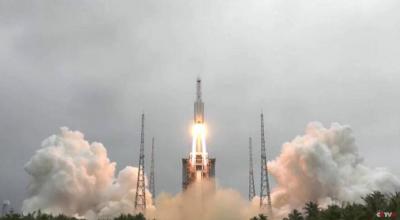Moments of anxiety grip humanity with each orbit of the rogue Chinese rocket around the Earth, after China lost control of it following its successful mission to transport the central capsule for building the new Chinese space station "Tianhe." The Chinese rocket "Long March 5B" raises questions about the fate of hundreds of satellites and rockets that have turned into debris after completing their missions and continue to float in space.
According to the American news network CNN, there exists a "cloud of debris" above the Earth weighing over 9,000 tons, equivalent to the weight of 720 school buses, consisting of hundreds of thousands—possibly millions—of objects in an uncontrolled orbit, including spent rocket boosters, "dead" satellites, and debris from anti-satellite missile tests.
Space debris is heavily concentrated in low Earth orbit. Although it does not pose a significant threat to humans, it endangers active satellites that provide us with services, including climate monitoring and enabling communications. According to the United Nations Office for Outer Space Affairs, there are currently 4,635 satellites orbiting the Earth.
Mokram Ibrahim, head of the Sun and Space department at the Astronomical and Geophysical Research Institute in Egypt, discusses the phenomenon of space debris. He mentions that there are two types of debris: one in low Earth orbit at an altitude of about 2,000 kilometers and another in high Earth orbit over 35,000 kilometers away.
Ibrahim adds that "the greatest danger lies in the debris in low Earth orbit, which gains speed due to its movement. It begins to descend to lower levels until it penetrates the Earth's atmosphere and then burns up." The Egyptian scientist explains that "this phenomenon is recurring and does not announce itself as a natural occurrence. Debris can change its trajectory due to collisions with other objects, descending until it penetrates the Earth's atmosphere, as is the case with the rogue Chinese rocket."
Outer space is filled with hundreds of "dead" satellites that have completed their missions and drift in the void. Ibrahim identifies these objects as space debris, and they sometimes collide with others in space. Over time, due to repeated collisions, the dead satellites are destroyed and turn into small particles.
Debris threatens the International Space Station, where crews of astronauts have lived since 2000, and they have had to adjust the station's orbit several times last year to avoid collision with space debris.
An international treaty regulates the movement of rockets returning from space to Earth. In 1967, the Outer Space Treaty was declared, which remains the fundamental international document for regulating activities in outer space. According to the treaty, the country launching a spacecraft retains control over it and is also responsible for any damage it causes, while also being required to avoid "polluting space."
According to the Egyptian scientist's statements to Sky News Arabia, the current situation constitutes a violation of the treaty, as China lost control of its rocket, which became a threat to Earth. Last year, the largest piece of space debris since 1991 from a Chinese rocket that went out of control and weighed 20 tons fell into the Atlantic Ocean after passing directly above Los Angeles and Central Park in New York City.




